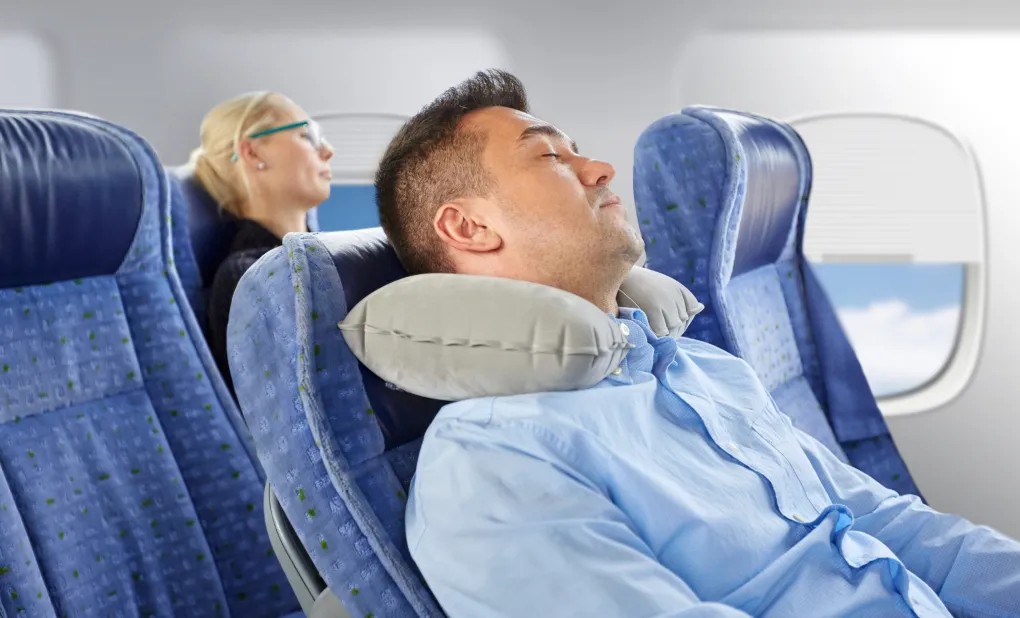For frequent travelers, getting a decent night’s sleep on the plane can be quite helpful in preventing jet lag and weariness. The alluring prospect of getting a decent night’s sleep on a lengthy flight and feeling refreshed upon arrival at your destination is certainly appealing. The truth, however, frequently differs. We examine the topic of sleeping on airplanes in this blog post and offer you helpful advice on how to slumber well even when you’re far above the clouds.
We’ll demonstrate when it makes sense to lie down on a flight and when it’s best to skip sleep. After all, it’s not always possible to get the best sleep while traveling, and there are a lot of considerations that must be made to ensure the best possible experience. We will also provide tested tips on how to overcome the difficulties of airplane pressure and determine the ideal sleeping position on the aircraft.
So read this blog to learn how to use your next flight as an opportunity for a peaceful sleep. This post will present you helpful tips to make your next flight more comfortable and peaceful, regardless of whether you’re an experienced regular flier or a once-in-a-lifetime vacationer.
Is it advisable to nap when flying?
Is it okay to nap while flying? Generally speaking, sleeping on an airplane is beneficial, especially for lengthy flights. Particularly if you arrive in a different time zone, sleeping aboard an aircraft can help you reduce jet lag and lengthen the duration of your journey. Arriving relaxed and rejuvenated is another benefit of getting a good night’s sleep on the aircraft. To guarantee a restful night’s sleep on the aircraft, a few factors need to be taken into account.
Not everyone, it should be noted, can get a good night’s sleep on a flight. In addition to turbulence or other discomforts that can interfere with sleep, some people find it difficult to fall asleep in new places. It is therefore wise to plan ahead and consider each person’s demands.
When you should not sleep on an airplane?
Sleeping aboard an airplane may not be the best option under certain circumstances. These consist of, for instance, shorter flights where sleep might be insufficient or even interfered with. When flying with a layover, it can also make sense to keep your eyes open to avoid missing your next trip. A summary of the things to keep in mind is:
Takeoff and landing: It’s critical to stay vigilant and adhere to safety procedures during these phases. At this point, travelers should be attentive and receptive.
Food Service: When flight attendants are serving meals When meal service is in progress, it is courteous and sensible to be awake to accept meals and make any necessary arrangements.
Brief flights: You might not have enough time to rest and go to sleep on a brief flight.
Health issues: Those who suffer from thrombosis or back issues, for example, may need to get up and move around frequently during longer flights rather than sleeping through the majority of them.
Procedures for emergencies: You must be awake and aware to obey the crew’s instructions in the unlikely event of an emergency.
How can one sleep on an airplane in the best way possible?
How can one sleep on an airplane in the best way possible? How should one sleep when flying? Being comfortable during long-haul flights is essential for getting a good night’s sleep on an airplane. Wear comfortable clothing and bring a neck cushion for head support. Try to acclimate to the time zone of your location and abstain from alcohol and caffeine right before bed. To reduce light and noise, wear an eye mask and earplugs. Also, try not to consume too much at once. To encourage circulation and prevent muscle stiffness, stretch before bed and take a few quick walks while flying.
Tips for long-haul flights on sleeping on airplanes
1. Select the appropriate seat; pay attention to your seating arrangement
Your comfort level during the trip may be greatly impacted by your seat selection. For instance, having a window seat is usually advantageous if you want to sleep well because it lets you lean against the cabin during the night. A seat in the aisle is useful, though, if you need to get up quickly or want easy access to the restroom. Because emergency exits frequently provide additional legroom, take that into account as well. Keep in mind that seats near restrooms and galleys tend to be busy. Seats next to kid zones on long-haul flights could be noisier. When selecting a seat, take into account your needs and preferences. Use your airline’s online check-in to reserve the ideal seat 24 hours before to departure.
2. Utilize the available chairs
Utilizing any unoccupied seats on the aircraft is another suggestion for a better night’s sleep. Try to find a seat next to you that is empty if the aircraft is not filled. Request to switch to an empty seat from a flight attendant as soon as the seat belts may be unfastened. You can spread out and get a better night’s sleep if there is an additional seat.
3. Choose appropriate attire and dress comfortably
Wearing comfortable clothing is a key strategy for getting a good night’s sleep on an aircraft. Choose airy, baggy clothing that doesn’t impede blood flow or feel constricting. Choose cozy socks or slip-ons rather than restrictive shoes to relieve pressure on your feet. Wearing layers will help you adjust to the aircraft cabin’s frequently fluctuating temperature. You’ll be able to unwind and get a better night’s sleep on the plane if you choose comfortable clothes.
4. Sleep on the aircraft to minimize disruptions
Minimize disruptions as much as possible to improve your quality of sleep when flying. To lessen disruptions from noise and light, select a seat far from places with heavy traffic, like restrooms or galley kitchens. To reduce outside noise, wear headphones with noise cancellation or earplugs. Put on a sleep mask to shield your eyes from bright light. To reduce any potential disruptions, let the flight attendants know that you would like to sleep during the journey. You can make the cabin quieter and more comfortable for a comfortable flight by doing these things.
5. Carry sentimental, private accessories
Bringing personal wellness items with you is crucial advice for a good night’s sleep on an airline. These include light-blocking eyewear for sleeping, earplugs, or headphones with a noise-canceling feature for reducing distracting sounds. Another alternative for noise reduction is to use earplugs. Basic personal hygiene products including toothpaste and toothbrush, deodorant, moisturizer, and hygiene wipes should always be brought on longer journeys. These travel essentials will make you feel more at ease and relaxed, which will improve your chances of getting a decent night’s sleep.
6. Let us upgrade you to economy class
Sleeping on a plane is typically a challenge for travelers. Asking for an upgrade on the airline is a wise move that could result in a better night’s sleep. Airlines occasionally provide upgrades if there are still seats available. Business class and premium economy class are examples of this, as they frequently provide better comfort and legroom. Additionally, keep an eye out for any mail-out offers or special deals your airline may be running that could lead to an upgrade. With any luck, you might be able to reward yourself with a more relaxing flight. You can sleep better and lie down more easily using these seats. Requesting an upgrade with grace doesn’t always backfire, particularly if the flight isn’t completely reserved. Though improvements aren’t always attainable, be ready for the possibility that they won’t always be available.
7. The ideal pillow—don’t overlook your neck pillows
Bringing an appropriate neck cushion (often known as an “airplane pillow”) on your flight will help you sleep soundly. When you wish to lean or sleep on your side, a neck pillow can help support your head and neck in addition to offering additional comfort. Certain neck pillows are made specifically for travel; they are lightweight, small, and easily fit in hand luggage. Selecting the ideal cushion for your sleeping preferences might significantly improve your ability to unwind and go off to sleep during your travel.
8. Create a bedtime ritual that includes sleep schedules
Establishing a nightly routine and a nighttime ritual are useful strategies for improving sleep on a flight. Even if you are in a foreign place, try to establish a habit that corresponds with your natural sleep rhythm. This might be as simple as reading a book, taking in calming music, or practicing deep breathing techniques. You can tell your body when it’s time to unwind and wind down by incorporating your unique sleep habits into your airplane sleep routine. Maintaining a regular sleep schedule will also help you get over jet lag and transition to different time zones faster.

